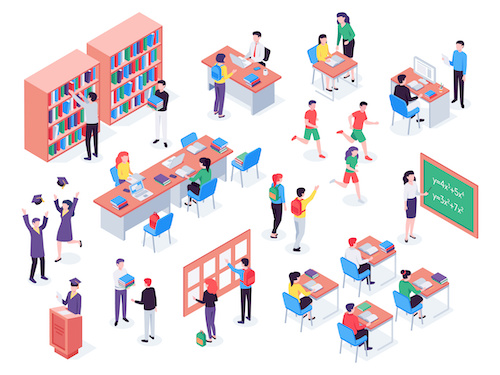When we built a new 3-story high school building on our former baseball field, we knew that we wanted to incorporate spaces where students could learn and teachers could teach in a very collaborative manner.
So, along with our new classrooms, in most areas of our school there are now two hallways with resource classrooms running down the center. Those are our collaborative spaces, and they’re where we got to be creative in terms of planning and design.
We didn’t want to just order 200 of the same chairs and hope for the best, so we worked with MiEN to select furniture designs and other elements that would best define and complement our new collaborative spaces. Here are four other steps we took to achieve our vision:
1. Match the space with the learning content. I wanted each area to include furniture that would best fit the students’ needs as they came in to use those spaces. In our English literacy content space, for example, the collaborative learning spaces need more of a “library feel,” complete with sofa-type furniture and soft seating. The vision was for students to come in and have Socratic seminars and maybe discuss a passage. The collaborative spaces focused on math, on the other hand, are tech-friendly with high tables, soft seating stools and large interactive whiteboard monitors for students working in groups. Science spaces combined the two concepts and included soft seating plus semi-circle high-top tables where students could congregate to solve complex science problems.
Related:
How outdoor learning spaces lead to STEM engagement
How to create engaging active learning environments
2. Balance practicality with fun. Ultimately, we really tried to match the furniture with the content that was being used and presented in that particular space. Our traditional school colors are blue, black, and white, but our furniture is not. We used fun pops of color—including lime green and orange—to create a bright learning environment that differs from the traditional classroom.
3. Find a partner that understands your vision. As we worked through the planning process for our new high school’s collaborative spaces, we had a lot of questions about furniture wear-and-tear. We wanted to know that our choices would stand the test of time. Our furniture partner was more than happy to help address these queries; we couldn’t have done it without them. They also shared visuals from other schools and showed us how certain products looked in certain environments (versus just having to pick from a catalog). And even when we changed our mind, they were always helpful by offering up new options and providing feedback on those changes.
4. Get everyone onboard. At first, our teachers were unsure about taking their classrooms to other places in the building for learning, and that was natural. However, as more and more of them began using and experiencing the collaborative spaces, even more of them wanted to try it out. We provided training on how to best use the spaces and our expectations for them (e.g., no lying down on the couches), and developed a Google Doc that teachers use to reserve the space in advance of their class time.
Taking Learning to New Levels
I also send out a weekly newsletter that includes pictures of the cool things that are happening on campus. I make sure to highlight how the collaborative spaces are being used so other teachers can see how they work. These are just some of the steps we’ve taken to help everyone get acclimated to our new school building and its wonderful new collaborative spaces, which we know will help us take learning to new levels.
- 3 ways to avoid summer learning loss - April 19, 2024
- High school students say AI will change the workforce - April 18, 2024
- Motivating students using the Self-Determination Theory - April 17, 2024


